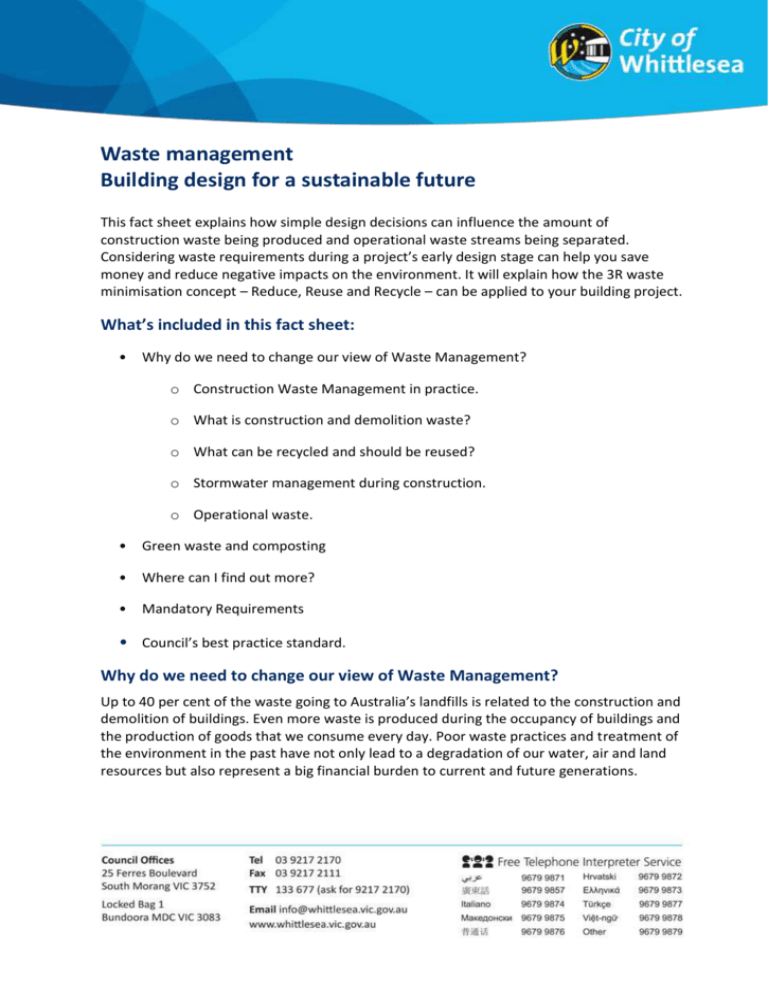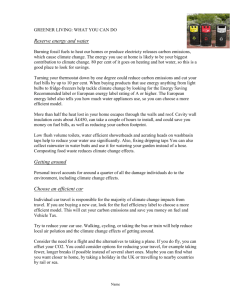Waste management - Building design for a sustainable future
advertisement

Waste management Building design for a sustainable future This fact sheet explains how simple design decisions can influence the amount of construction waste being produced and operational waste streams being separated. Considering waste requirements during a project’s early design stage can help you save money and reduce negative impacts on the environment. It will explain how the 3R waste minimisation concept – Reduce, Reuse and Recycle – can be applied to your building project. What’s included in this fact sheet: • Why do we need to change our view of Waste Management? o Construction Waste Management in practice. o What is construction and demolition waste? o What can be recycled and should be reused? o Stormwater management during construction. o Operational waste. • Green waste and composting • Where can I find out more? • Mandatory Requirements • Council’s best practice standard. Why do we need to change our view of Waste Management? Up to 40 per cent of the waste going to Australia’s landfills is related to the construction and demolition of buildings. Even more waste is produced during the occupancy of buildings and the production of goods that we consume every day. Poor waste practices and treatment of the environment in the past have not only lead to a degradation of our water, air and land resources but also represent a big financial burden to current and future generations. Therefore, it is becoming increasingly important to minimise, separate and recycle waste. This will lead to significant social, economic and environmental benefits. By reducing, recycling and reusing waste you can: • reduce the amount of waste going to landfill • reduce emissions, pollution and contamination • protect scarce resources • reduce overall construction costs • reduce tipping fees • sell salvaged recourses • contribute towards Council’s waste reduction targets for your community. Construction Waste Management in practice The most effective waste minimisation strategies are those that have been developed throughout a project’s design stages and have been agreed to by all parties involved. Building designers make the key waste minimisation decisions, including whether an existing building will be completely demolished or partially retained. They decide on the materials being used and the construction methods to be employed. “It’s time we realise that waste is an asset, and not a problem. Through informed design, alternative waste treatment and effective resource recovery, money can be saved at every stage of building development.” At the specifications stage, further decisions about materials and their handling are to be made. Which materials contain recycled contents and can be recycled in the future? Are materials and finishes durable and can they be easily maintained? And, can cutoffs and packaging be recycled? At the contract documentation and tendering stage, it is time to develop a waste management plan that describes clear key performance indicators (e.g. total minimum recycling rate). This is important so that all tenderers factor best practice waste management into their price. Think about additional financial incentives for exceeding minimum waste recycling targets. Consider selecting a contractor that has proven experience with sustainable waste Page 2 of 7 management practices. Discuss a monitoring process to ensure your waste management expectations have been met. The construction stage is where all waste management strategies are implemented. To ensure that contractors are able to meet described process and targets, we recommend the following: • • Allow for sufficient space on site to accommodate not only new materials, but also different skips for different waste and recycling streams. Clearly label individual skips and bins and protect them from contamination, rain and wind. • Organise regular pick up of skips and bins to avoid overloading or false use of containers. • Ensure sub-contractors are fully aware of the site’s waste management practices. • Make sure written contracts with trades include waste minimisations practices. • Provide separate bins for household waste. • Ask suppliers to collect/recycle packaging. What is construction and demolition waste? Waste Description Percentage of total waste (by weight) Soil 36 Concrete-based masonry 16 Bricks and tiles 16 Timber 10 Vegetation 3 Metals 2 Plasterboard 2 Hard plastic 1 Paper 1 Others 13 Total construction waste 100 The biggest impact on construction waste volume can be made at the early design stage. Determining what extent of an existing building is to be demolished or reused is often a key design decision. Consideration should be given to a total life cycle assessment of an existing material or product. Of course, retaining or reusing as much as practically possible, should be the aim. Developing a Waste Management Plan that describes what materials will be reused on site or separated for offsite recycling is a very effective way of reducing waste going to landfill. As a rule of thumb, a minimum of 70% of waste (by mass) of all demolition and construction waste should be recycled or reused. The table to the left demonstrates what quantities of materials are commonly disposed during a building’s construction. Page 3 of 7 What can be recycled and should be reused? Most construction and demolition materials can be recycled. Often, it is just a matter of separating waste, either on-, or off-site and sending it to the relevant waste stream. Many waste contractors are specialised in this area and will be able to provide you with detailed advice. Below is an overview of common materials and the relevant recycling/reuse opportunities: • Steel can be melted and reused within new steel products. Using recycled steel reduces the embodied energy by 72%. • Aluminium can be 100% recycled. Using recycled aluminium reduces the embodied energy by 95%. • Gypsum plasterboard can and should be recycled as when it is disposed to landfill, it produces poisonous hydrogen sulphide. • Timber can either be directly reused or turned into horticultural mulch. If not recycled, always specify sustainably sourced timber. • Concrete can be crushed and recycled as aggregate for new concrete or road base and fill. Specify concrete with recycled aggregate in all viable applications. • Glass can be reused as aggregate for concrete. • Bricks and tiles can either be directly reused or crushed for backfill, aggregate and gravel. • Plastics can often be granulated and reused to make new plastic products. “Having recently moved into a new apartment building made me realise, how easy waste separation can be. My kitchen joinery contains three bins (waste, recycling and food scraps), our waste area is on my way out and bins are clearly labelled.” Stormwater management during construction Construction sites can represent a great burden on local waterways. Site litter, paint, solvents, bricks, cleaning substances and clean-fill can all contaminate stormwater runoff. It is an offence under the Environment Protection Act to discharge contaminated water into the stormwater system. To avoid contamination, ensure that a drainage system is installed before construction activities commence and storm water is diverted from areas where soil is exposed. Page 4 of 7 Operational waste Dedicated storage spaces should be allocated for the collection and sorting of waste. These spaces should be easily accessible to all building occupants and be in close proximity to waste collection points. Bins or storage containers should be allocated to accommodate different waste streams including recyclable waste, rubbish (non-recyclable waste), oversized household items, green waste, composting and small containers for hazardous waste, such as batteries and fluorescent light bulbs. It is important that storage areas are conveniently located within a development and have been designed to accommodate space for signs and education material. Furthermore, simple design decisions, such as the provision of in-built kitchen bins for different waste streams and separate waste chutes (general waste and recyclable waste) in apartment buildings can make a big difference. Recycling bins should be sized and located to accommodate paper, cardboard, glass, plastics and metals. Rubbish bins should only accommodate common waste that cannot be recycled or composted and will go to landfill. Page 5 of 7 Green waste and composting Green waste includes garden waste, such as branches, prunings and grass clippings. Composting includes largely food waste and should, like green waste be separated from common waste. Wherever possible, provisions should be made for onsite composting of food and green waste at a project’s early design stage. Alternatively, contact your Council for detailed advice on green waste and composting services. Bear in mind that different composting systems have different spatial requirements. So when designing a new home or multi-unit residence, ensure that composting of food scraps and possibly garden waste can be accommodated within the site. Mandatory Requirements and Council’s Best Practice Standard Environmental Sustainable Design (ESD) Principles There are two levels of compliance when it comes to ESD principles – mandatory and best practice. Page 6 of 7 Mandatory Requirements Construction Waste – to the satisfaction of the relevant local authority. Operational Waste – to the satisfaction of the relevant local authority. Council’s Best Practice Standard Building design should incorporate features that take into account a building’s whole life cycle: • Adopt a recycling target of at least 70% for all demolition and construction waste (by mass). • In addition, adequate facilities must be provided to ensure waste separation and possible on-site reuse is facilitated during the building’s operation. Developments, which seek to vary from these best practice standards, must demonstrate how sustainable waste management can be satisfactorily achieved. Where can I find out more? Waste Minimisation Technical Manual Your Home www.yourhome.gov.au Guide to Best Practice for Waste Management in Multi-unit Developments Sustainability Victoria www.resourcesmart.vic.gov.au Download waste separation wall posters and bin lid stickers Sustainability Victoria. Towards Zero Waste Strategy Sustainability Victoria www.sustainability.vic.gov.au Reducing Stormwater Pollution from Construction Sites, publication 981 Environmental Protection Authority Victoria www.epa.vic.gov.au Also refer to Council’s website for details on recycling, green waste and composting services. Other Fact Sheets in this series are also available to provide guidance on the 10 Key Sustainable Building Categories. For further information on Waste Management, consider the Fact Sheets entitled: • Building Materials • Stormwater Management • Construction & Building Management Page 7 of 7







